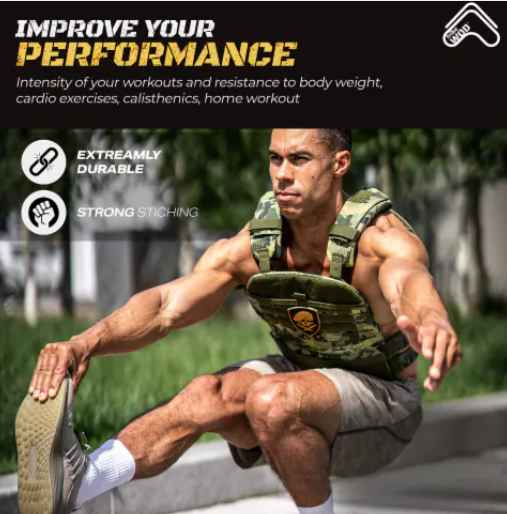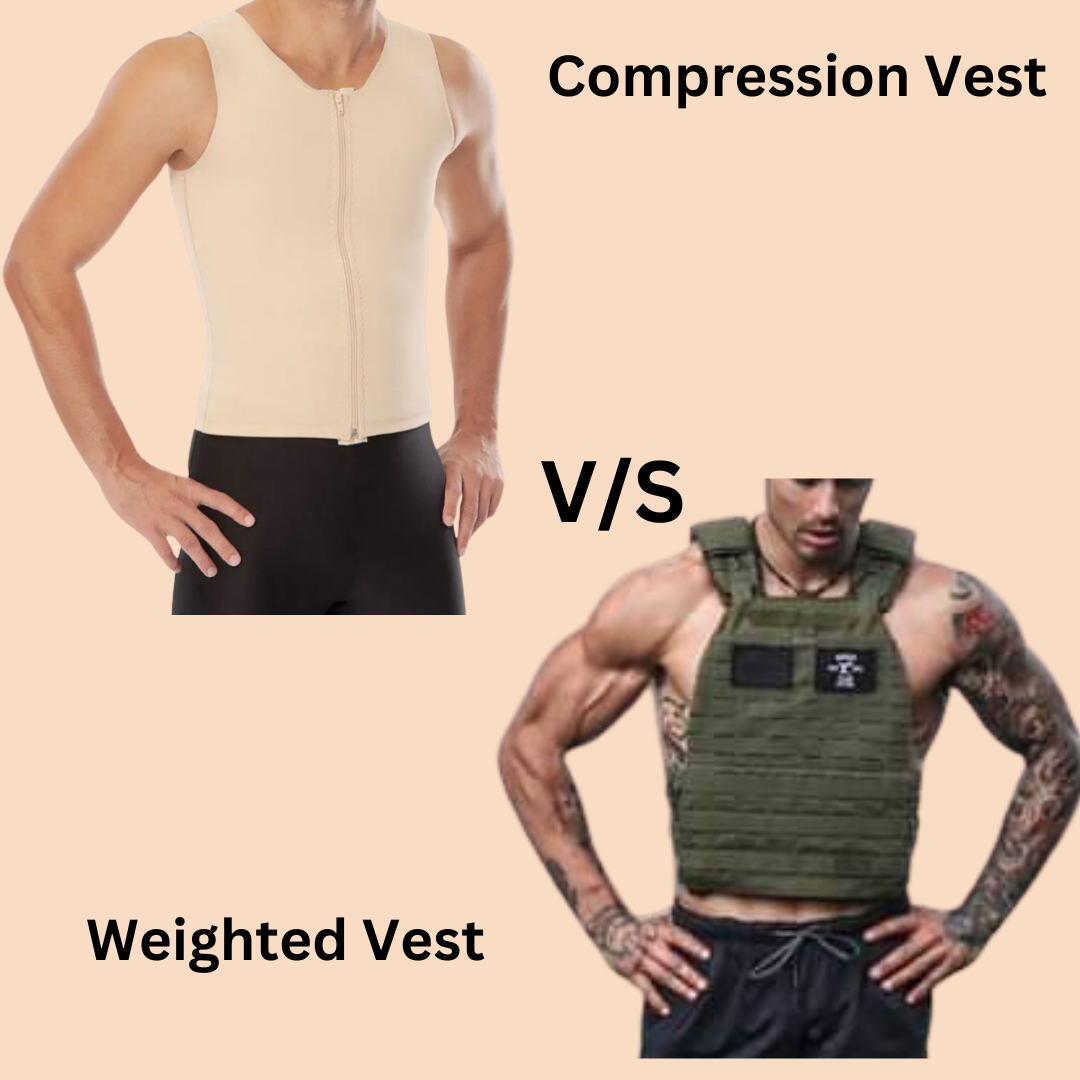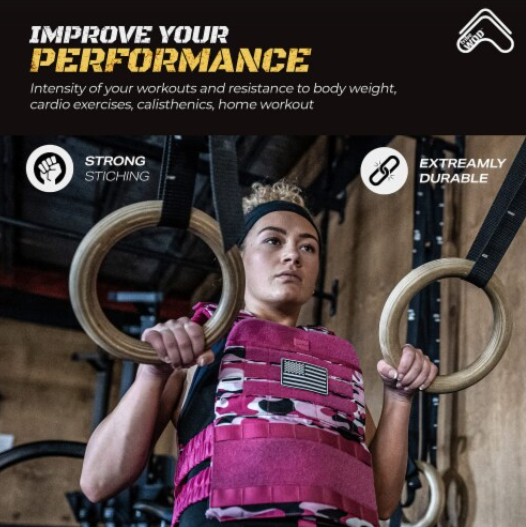Weighted vests have become increasingly popular in fitness routines, offering a versatile way to add resistance to various exercises. Understanding the specific muscles targeted by weighted vest workouts is essential for maximizing their effectiveness and achieving desired fitness goals. In this comprehensive guide, we'll delve into the muscles engaged during weighted vest exercises, exploring their roles and benefits in promoting overall strength, stability, and endurance.
Muscles Engaged in Weighted Vest Workouts

Embarking on a fitness journey involves a myriad of exercises aimed at sculpting the body, enhancing strength, and improving overall health. Among the array of workout regimens, the integration of weighted vests has emerged as a powerful method to amplify the effectiveness of exercises. These vests add resistance to movements, challenging various muscle groups and elevating the intensity of workouts. Understanding the intricate interplay between weighted vests and muscle engagement is paramount for optimizing fitness routines. In this exploration, we delve into the specific muscles targeted during weighted vest workouts, unraveling the dynamic synergy between resistance and muscular activation.
Core Muscles
- Weighted vest exercises often place significant demands on the core muscles, which play a crucial role in stabilizing the body during movements. The rectus abdominis, commonly known as the "six-pack" muscles, along with the obliques and transverse abdominis, work together to maintain proper posture and spinal alignment.
- The rectus abdominis muscles, positioned prominently along the anterior abdominal wall, are key players in flexing the spine and stabilizing the pelvis. These muscles are highly engaged during movements that require forward bending or trunk flexion, such as crunches or sit-ups. Additionally, the obliques, located along the sides of the abdomen, contribute to rotational movements and lateral flexion of the spine. Their activation is particularly pronounced during exercises involving twisting motions or side bends.
- Moreover, the transverse abdominis, often regarded as the body's natural corset, provides vital support to the spine and internal organs. This deep-seated muscle acts as a stabilizer, aiding in the compression of abdominal contents and maintaining intra-abdominal pressure. Its engagement is crucial for maintaining core stability and preventing excessive movement of the spine during weighted vest exercises. Collectively, these core muscles work synergistically to fortify the trunk and uphold structural integrity, facilitating controlled and effective movements throughout weighted vest workouts.
Lower Body Muscles
- Squats, lunges, and jumps with a weighted vest primarily target the lower body muscles, including the quadriceps, hamstrings, glutes, and calves. These exercises not only strengthen the major muscle groups of the legs but also improve stability and balance.
Integrating a weighted vest into exercises such as squats, lunges, and jumps amplifies the challenge for the lower body muscles, fostering substantial gains in strength and stability. These dynamic movements predominantly target several key muscle groups, including the quadriceps, hamstrings, glutes, and calves, forging a robust foundation for enhanced athleticism and functional movement patterns.
The quadriceps, situated at the front of the thigh, serve as primary movers during exercises like squats and lunges, facilitating knee extension and powering upward movements. By bearing the brunt of the resistance added by the weighted vest, these muscles undergo significant activation, fostering muscle growth and strength development. Conversely, the hamstrings, located at the back of the thigh, act as antagonists to the quadriceps, stabilizing the knee joint and aiding in hip extension during movements like lunges and jumps.
- Research has demonstrated that adding external resistance, such as a weighted vest, to lower body exercises can lead to greater muscle activation and strength gains compared to bodyweight exercises alone
Upper Body Muscles
Integrating weighted vests into exercises such as push-ups, pull-ups, and planks serves as a catalyst for engaging the upper body muscles comprehensively. These compound movements elicit activation in various muscle groups, including the chest, shoulders, back, and arms, fostering strength gains and functional fitness improvements.During push-ups, the chest muscles, specifically the pectoralis major and minor, are primary movers responsible for shoulder flexion and arm extension. The added resistance from the weighted vest intensifies the workload on these muscles, prompting greater muscle activation and facilitating muscle hypertrophy.
Additionally, the deltoid muscles of the shoulders play a crucial role in stabilising the shoulder joint and assisting in the pushing motion during push-ups.
Moreover, exercises like pull-ups and chin-ups target the muscles of the upper back, including the latissimus dorsi, trapezius, and rhomboids. These muscles act synergistically to pull the body upward against gravity, with the added resistance from the weighted vest further challenging their strength and endurance. By engaging in these pulling movements, individuals not only develop upper back strength but also improve posture and shoulder stability.
-
Postural Muscles
The erector spinae muscles, located along the spine, function to extend the vertebral column and provide stability to the spine during movement. By wearing a weighted vest during activities like walking or running, individuals impose additional resistance on the erector spinae, prompting greater muscle activation and enhancing their strength and endurance. Strengthening these muscles contributes to improved posture and spinal alignment, reducing the likelihood of postural imbalances and associated discomfort.
Similarly, the trapezius muscles, spanning the upper back and neck, are crucial for shoulder and neck stability and play a significant role in maintaining proper posture. When wearing a weighted vest during activities that involve upper body movement, such as walking or running, the trapezius muscles are engaged to stabilise the shoulders and support the weight of the vest. Strengthening the trapezius muscles enhances shoulder stability and contributes to maintaining an upright posture, thereby reducing strain on the neck and upper back.
By incorporating weighted vest activities that target postural muscles, individuals can improve their posture, reduce the risk of musculoskeletal injuries, and alleviate back pain. Strengthening these muscles enhances overall stability and alignment, promoting optimal biomechanics and facilitating pain-free movement during daily activities.
Studies have shown that weighted vest use can have positive effects on posture and attention to task in various populations. Study published in the National Library of Medicine reported that preschoolers with pervasive developmental disorders showed improved attention to task and reduced self-stimulatory behaviours when wearing a weighted vest.
-
Cardiovascular Muscles
Engaging in cardiovascular activities like jogging or stair climbing with a weighted vest increases the workload on the heart and lungs, enhancing cardiovascular endurance. This form of resistance training not only improves aerobic capacity but also promotes fat loss and enhances overall metabolic health. During cardiovascular exercises, the heart muscles, particularly the myocardium, work tirelessly to pump oxygen-rich blood throughout the body to meet the heightened demand for energy. Wearing a weighted vest adds an additional challenge to the cardiovascular system, compelling the heart to work harder to sustain the increased workload.
Over time, this results in improved cardiac efficiency, enhanced stroke volume, and a more robust cardiovascular system capable of meeting the demands of vigorous physical activity. The respiratory muscles, including the diaphragm and intercostal muscles, play a pivotal role in facilitating breathing during cardiovascular exercises. As individuals engage in activities like jogging or stair climbing with a weighted vest, these respiratory muscles work in tandem to expand and contract the lungs, enabling efficient gas exchange and oxygen delivery to the muscles. This enhanced respiratory function contributes to improved endurance and delays the onset of fatigue during prolonged exercise sessions. Incorporating weighted vest cardiovascular workouts into a fitness regimen can promote fat loss and improve metabolic health.
The increased intensity of these exercises elevates the calorie expenditure and stimulates the metabolism, leading to greater fat oxidation and weight management benefits. Furthermore, the cardiovascular adaptations induced by weighted vest training, such as improved insulin sensitivity and lipid profile, confer long-term health advantages and reduce the risk of chronic diseases like diabetes and cardiovascular disease. By integrating cardiovascular activities with a weighted vest into their fitness routines, individuals can unlock a multitude of benefits, including enhanced endurance, fat loss, and metabolic health improvements. This innovative approach to cardiovascular training offers a dynamic and efficient means of achieving fitness goals while promoting overall health and well-being.
According to the American Council on Exercise (ACE), incorporating external resistance, such as a weighted vest, can elevate heart rate and oxygen consumption during aerobic activities.
Benefits of Targeting Multiple Muscle Groups
-
Efficient Workouts
Weighted vests enable individuals to perform compound exercises that engage multiple muscle groups simultaneously, enhancing workout efficiency and calorie burn. By incorporating exercises such as squats, lunges, and push-ups with a weighted vest, individuals can effectively target various muscle groups in a single movement. This multi-muscle engagement optimises time spent during workouts, allowing individuals to achieve more in less time. As a result, weighted vest workouts are not only time-effective but also enjoyable, providing a challenging and rewarding fitness experience.
Functional Strength
- Targeting a wide range of muscles through weighted vest exercises improves functional strength, which is crucial for performing everyday activities with ease and efficiency. Functional strength encompasses the ability to lift, bend, and reach without experiencing strain or discomfort. By engaging in exercises that mimic real-life movements, such as carrying groceries or lifting objects from the ground, individuals develop functional strength that translates into improved performance in daily tasks. Additionally, enhanced functional strength reduces the risk of injury during activities of daily living, promoting overall well-being and quality of life.
Balanced Development
- Weighted vest workouts facilitate balanced development of both upper and lower body muscles, promoting symmetrical muscle growth and overall fitness. By incorporating a variety of exercises that target different muscle groups, individuals can achieve a balanced and well-rounded physique. Exercises such as pull-ups, rows, and chest presses with a weighted vest engage the upper body muscles, while squats, lunges, and calf raises target the lower body muscles. This balanced engagement ensures that all major muscle groups are adequately stimulated, preventing muscle imbalances and promoting optimal physical performance. As a result, individuals experience improved posture, stability, and coordination, enhancing their overall fitness and athletic performance.
Conclusion
Incorporating weighted vest exercises into your workout routine effectively targets various muscle groups, enhancing strength, stability, and endurance. By understanding the muscles engaged in weighted vest workouts and their respective benefits, individuals can design a well-rounded fitness program to achieve their fitness goals effectively. Whether you're looking to strengthen your core, sculpt your legs, or improve your cardiovascular health, weighted vests offer a versatile and efficient way to elevate your workouts and take your fitness to the next level.










